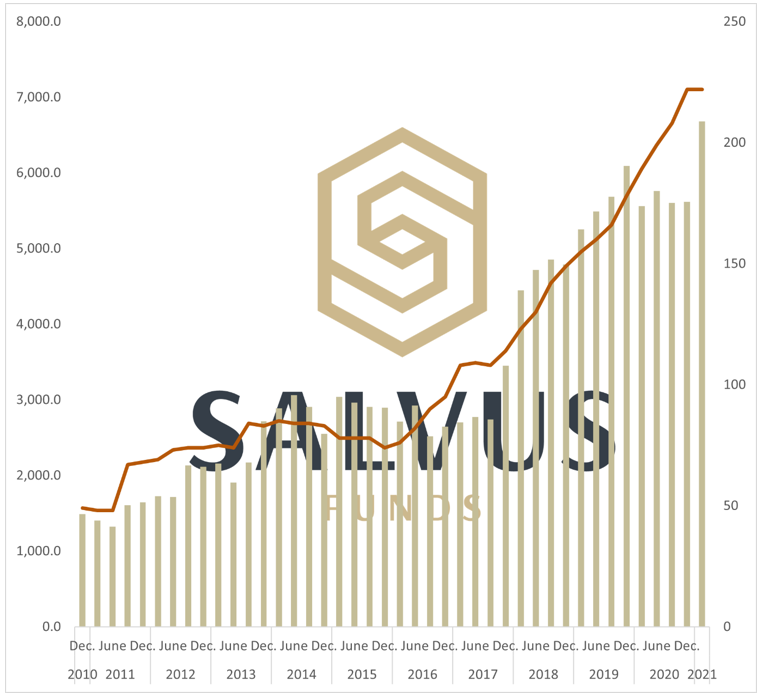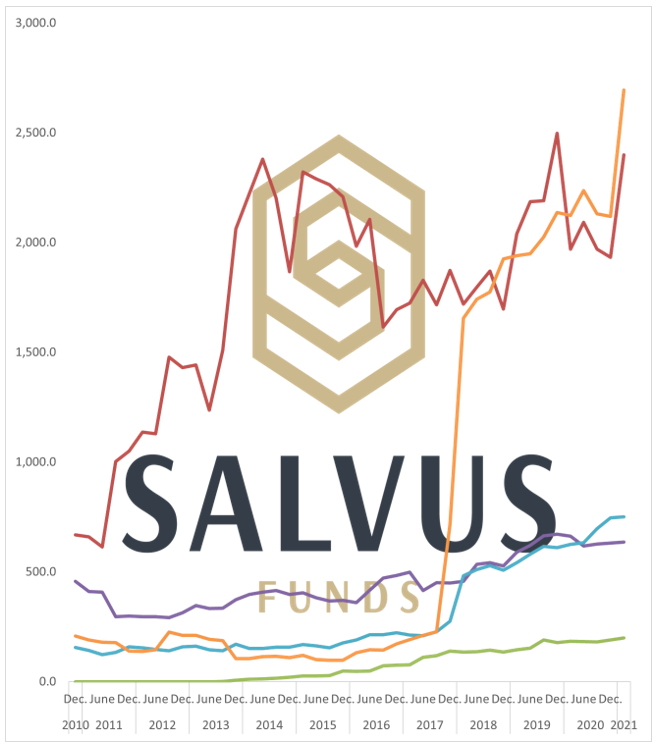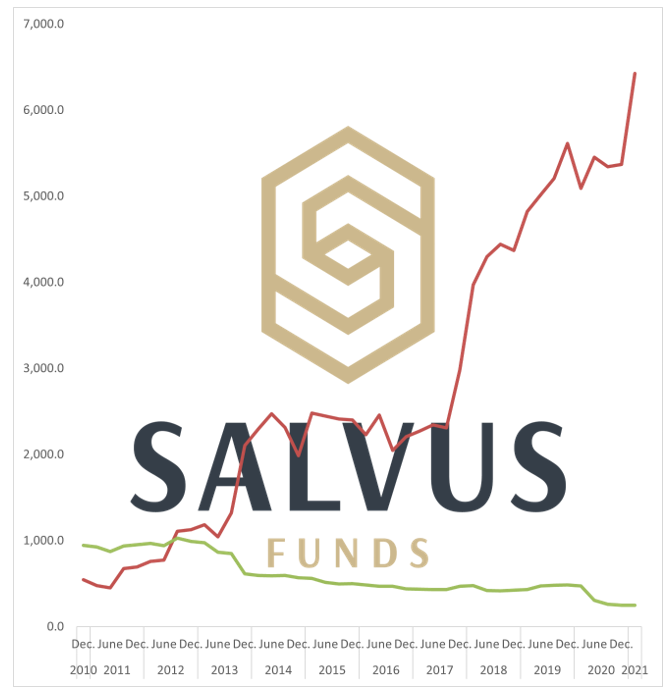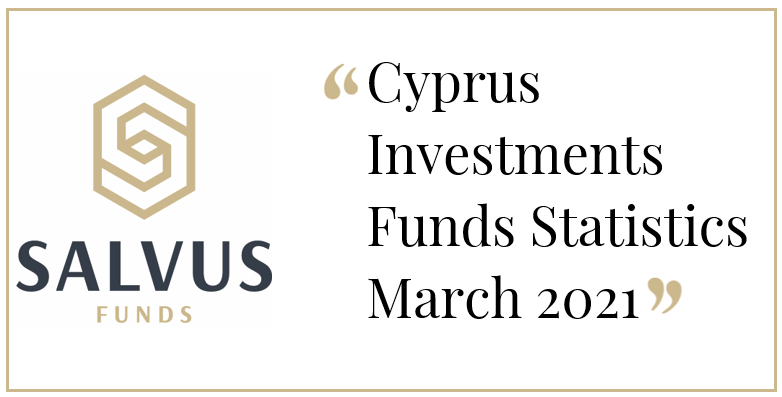Cyprus Investment Funds Statistics – March, 2021
In May 2021, the Statistics Department of the Central Bank of Cyprus (CBC) released its statistics update for Investment Funds based in Cyprus. As the reporting frequency is quarterly, the current dataset period includes data until the 31st of March, the 1st quarter of 2021.
This particular set of data captures the 5th quarter of the Covid-19 pandemic, and it is the first that includes the psychological (and immunisation) impact from the different vaccinations programs around the world. The coronavirus crisis has so far
- caused the global markets crash within February 2020,
- partly recovering within March, having a noticeable impact in the investment funds industry in Cyprus then,
- rallying on the US elections outcome along with news on successful vaccines tests against the novel coronavirus,
- and most countries in the world experiencing a strong second (or third in some cases) wave of new cases.
The statistics are presented in the following 5 tables:
- Investment funds balance sheet data: assets,
- Investment funds balance sheet data: liabilities,
- Investment funds total assets/liabilities, by nature of investment,
- Investment funds total assets/liabilities, by type of investment fund,
- Investment funds total assets/liabilities, UCITS/Non-UCITS breakdown.
The Investment funds balance sheet data: assets table
The total assets outstanding at the end of March 2021, were reported at 6,678.4 million EUR. This is an 18.9% increase following the previous report on total assets, which reported a minimal increase of 0.25%. This increase in the reported total assets is an all-time high and should be considered of extreme importance. At 6.6 billion EUR this is an increase of 1 billion EUR in Assets Under Management in a single quarter. The previous record was at 6.1 billion EUR recorded back in December 2019.
The data on the number of reporting entities remained unchanged, after 13 consecutive quarter-over-quarter increases. This does not equate with a hold in the growth trend that has resulted in 222 entities. The net-zero additional entities, saw the registration of 8 new RAIF (Registered Alternative Investment Funds), another vote of confidence in the investment vehicle.
Figure 1 below, combines these 2 data sets with
- the y-axis on the left and the bars along the x-axis showing the Total Assets in EUR million, outstanding,
- the y-axis on the right and the line along the x-axis showing the Number of Reporting Entities,
at the end of each period.

Figure 1 – The progress of Total Assets in EUR million (bars), outstanding at end of period and the Number of Reporting Entities (line) since end of December 2010 until end of December 2020.
The Investment funds balance sheet data: liabilities table
The breakdown of the liabilities on the balance sheet of Investment Funds in Cyprus is reported in 3 categories by the CBC:
- Loans
- IF (Investment Funds) shares/units
- Other liabilities (incl. financial derivatives)
Most liabilities are consistently coming from IF shares/units with 5,853.4 EUR million outstanding at the end of March 2021 amounting to 87.7% of the total liabilities of Investment Funds in Cyprus. This increase is the sole reason for the total overall AUM increase for the jurisdiction as a whole. Loans follow with an increase quarter-over-quarter at 631.5 EUR million outstanding (9.5%) and finally, other liabilities (incl. financial derivatives) amount to 193.4 EUR million outstanding (2.9%).
The Investment funds total assets/liabilities, by nature of investment table
The breakdown by nature of investment of the assets/liabilities on the balance sheet of Investment Funds in Cyprus is collected in 5 categories (Figure 2) by the CBC:
- Equity
- Bond
- Mixed
- Real Estate
- Other
Compared to the end of the previous period at the end of December 2020, all categories Real Estate, Bond, Equity, Other and Mixed recorded an increase. This has maintained Real Estate (blue line in Fig.2) as the 3rd biggest category ahead of the Mixed (purple line in Fig.2) category. Equity remains in 2nd place behind Other. The second biggest asset class, Equity (red line in Fig.2), reported an increase, in outstanding amount terms, of 466.9 EUR million. The total outstanding, for Other (orange line in Fig.2) asset class, was recorded at 2,693.4 EUR million.

Figure 2 – The progress of total assets/liabilities in EUR million (bars), outstanding at end of period broken down by nature of investment.
The Investment funds total assets/liabilities, by type of investment fund table
The type of investment funds is split into Open End and Closed End.
As shown in Figure 3, the consistent theme of decreasing Closed End Investment Funds total assets/liabilities came at a hold after the all-time low recorded in the previous quarter at 249.0 million EUR (green line in Fig. 3), while the increase in Open End (red line in Fig.3) was equal to 1,060.0 million EUR bringing the total for the category at 6,427.8 EUR million.

Figure 3 – The progress of the total assets/liabilities in EUR million (bars), outstanding at end of period broken down by type of investment fund.
The Investment funds total assets/liabilities, UCITS/Non-UCITS breakdown table
The final table of the Investment Funds Statistics as reported by CBC shows total assets/liabilities for both, UCITS and Non-UCITS investment funds. As reported in our previous commentary on the investment funds in Cyprus,
- at the end of March 2020, total assets/liabilities for UCITS amounted to 321.6 EUR million outstanding while for Non-UCITS, the total assets/liabilities were reported at 5,242.3 EUR million outstanding,
- at the end of June 2020, these had increased to 366.2 million EUR and 5,394.4 million EUR for UCITS and Non-UCITS respectively. In the previous period to this one, (data up to the end of September 2020), had reported UCITS and Non-UCITS at 365.4 million EUR and 5,237.3 million EUR respectively,
- at the end of the year 2020, has UCITS and Non-UCITS at 411.4 million EUR and 5,205.5 million EUR respectively,
- and the current report which includes data up to the end of March 2021, has UCITS and Non-UCITS at 441.9 million EUR and 6,678.4 million EUR respectively.
Conclusion
One quarter at a time, the work done by all stakeholders to cement Cyprus as an investment funds jurisdiction is proving itself. This particular quarter has seen an exceptional performance in terms of AUM, irrespective of the unchanged sum of the number of reporting entities. After the very strong 2019 and the conclusion of a mixed 2020 in terms of total assets, the continuously increasing number of reporting entities is a testament to the tenacity of the Investment Funds industry in Cyprus, with this resulting in an all-time high 6.6 billion EUR AUM. Among the main drivers, one is the Registered Alternative Investment Fund (RAIF) as the investment fund type of choice.
The vaccination programs are having a positive impact on the Covid-19 pandemic, a crisis that has interrupted economic activity like no other event and forced disruptive developments across many different business verticals. This quarter’s data and the work of CySEC and CIFA, the Funds service providers and SALVUS, are obvious pillars for the growing AUM in this jurisdiction. The very strong increase of the assets under management is seen by us at SALVUS Funds as an opportunity to work harder towards a more complete Investment Funds ecosystem in Cyprus.
As always, we welcome creative thinking and an optimistic attitude in facing this crisis as an opportunity. Part of our public #StayAhead commitment is exactly about that. We remain committed to contributing further and aiding in this recovery and our clients and partners growth.
Do not hesitate to contact us if you require further information. We will be glad to support you in finding an appropriate solution or answering your questions.
#StayAhead.
Should you be interested to read about relevant topics on the funds sector, feel free to visit our earlier articles:
- The different types of Alternative Investment Funds
- Questions on Registered Alternative Investment Funds (RAIF) in Cyprus
- AIFMs, UCITs and the Liquidity stress Tests (LST)
- Is it all gloom and doom for hedge funds returns (YTD)?
- The Reasons AIFM, AIF and RAIF come to Cyprus
- The Cypriot AIF: legal forms, types and requirements
- The Cypriot RAIF: substance, requirements and tax
- Cyprus Investment Funds Statistics – December, 2020
- Cyprus Investment Funds Statistics – November, 2020
- Cyprus Investment Funds Statistics – August, 2020
- Cyprus Investment Funds Statistics – May, 2020
- Cyprus Investment Funds Statistics – February, 2020
The information provided in this article is for general information purposes only. You should always seek professional advice suitable to your needs.

